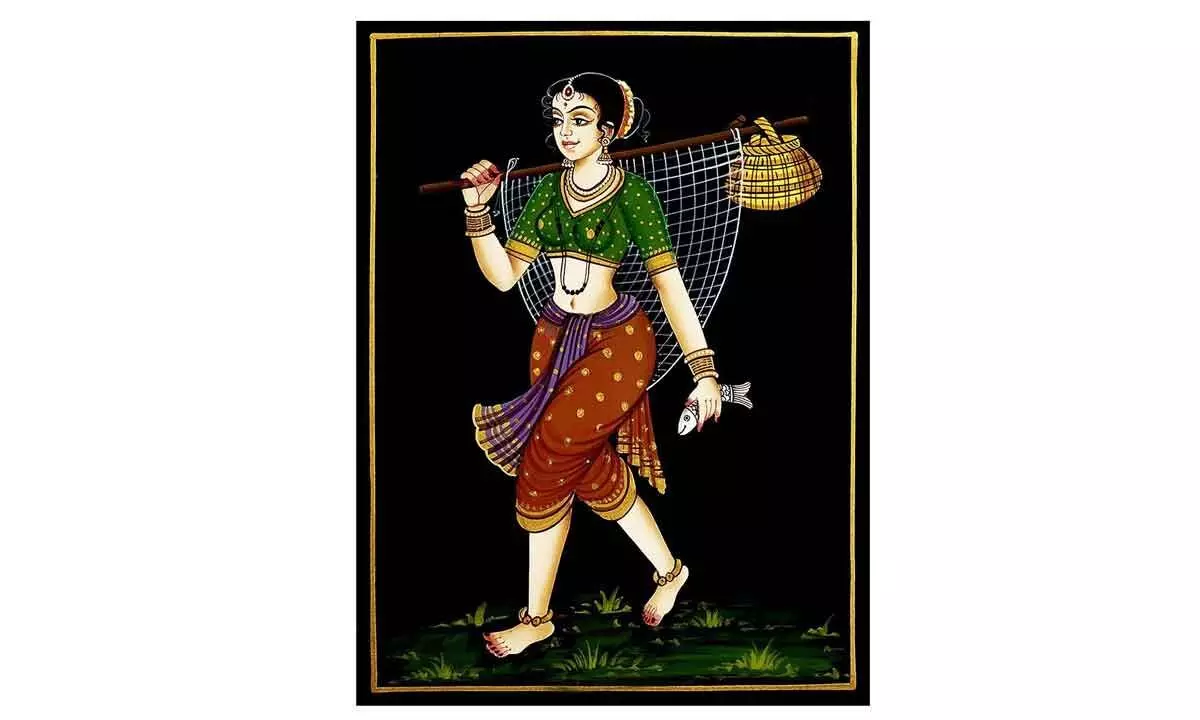Live
- Union Minister Bandi Sanjay Visits Injured Boy Sritej at KIMS Hospital
- Construction of over 1,000 bridges underway in Assam: CM Sarma
- Telangana IAS Officers wives association meets president Droupadi Murmu
- Nara Devaansh Sets World Record with Checkmate Marathon
- India set to become developed nation by 2047: Haryana CM
- Allu Arjun’s house attacked by protesters demanding compensation for the stampede victim
- Several Gulf countries impose visa ban on Pakistanis over their involvement in crime, fraud and begging
- Public outrage in Jharkhand's Giridih over murder, police station gheraoed
- Santosh Trophy: Meghalaya edge Goa 1-0 to secure QF berth
- Army's swift action prevented Kolkata fire from spreading: Defence Ministry
Just In
Breathing life into imagination-the art of Nirmal paintings


Ethereal paintings, depicting scenes from Indian epics, have been a regular sight in most households in Andhra Pradesh and Maharashtra.
Ethereal paintings, depicting scenes from Indian epics, have been a regular sight in most households in Andhra Pradesh and Maharashtra. Vibrant by design and precise in strokes, these paintings have also always added to the minimalism of a wall – yes, they never interfered. Perhaps, it's those colours that evoke music in our minds (and therefore it doesn't seem like noise on the walls) or it's the clarity in the scene painted that brings alive a multitude of emotions and a sense of calm all at once. We may not be sure which is which, but such is the mysterious magnetism of Nirmal paintings.
A traditional art form, named after the tribal town Nirmal – in Adilabad, a celebrated hub for oil paintings – Nirmal paintings trace their steps back to the Kakatiya dynasty. Admired dearly for its regal motifs such as frescoes from the popular historical monuments Ajanta & Ellora, Mughal miniatures and floral designs; these paintings have always been synonymous with the word charming! Around four centuries ago, back in the tribal town of Nirmal, artisans dedicated their lives to painting designs and glorious stories on wooden furniture and fort walls. These artisans belonged to a community of painters called Nakkash, who for centuries, have joyously been painting sprightly Nirmal paintings. What started as a cluster, soon was patronised by the Nizam of Hyderabad, who handpicked a few artisans from the town of Nirmal and expanded the craft's presence by establishing it in Hyderabad.
Therefore, besides the scenes from Indian epics, beautiful landscapes, exotic tribal women, celestial nymphs and characters from mythological stories, Nirmal paintings also derive heavy influence from the Mughals.
The seeming simplicity of the final paintings is preceded by hours of pain-staking detailing by the artisans. From ensuring the frame is sized, shaped and smoothened; to priming the same for the painting process, Nirmal paintings are revered for not one, but several reasons. The frame preparation involves sizing, and the plank preparation involves the spraying of moisture-absorbing Luppa paint to increase the longevity of the wood. Following this, a layer of black paint is sprayed to give it the quintessential base for our good old Nirmal paintings. The choice of wood for the paint-board, back in the day, used to be white wood (of Tella Poniki tree), however, to keep up with the changing times, artisans also introduced Indian teak wood – owing to its longer-lasting quality, delicate texture and weight, coupled with its strength. In the earlier days of this craft's evolution, the paints that were used were extracted from the vibrant stones belonging to the shores of the Godavari river as well as from various herbs and mud. As for today, spray, oil paints and acrylic colours are mixed with adhesives (such as fevicol) to prime it for painting. Such is the artisans' perseverance to nail the design right, that the designs are first traced – either in chalk on smoothened wood or a composition board – and are then painted in solid and lively colours before they are finally touched up with a dash of gold and varnish. To finish it up, a clear spray is used on the final painting to induce water resistance and also add an extra kick of shine!
Call it a new trend or evolution of Nirmal's craft, its entry into the furniture segment (in the last two decades) has been a heart-warming sight to witness. Furniture such as sturdy stools, exquisite pooja mandir platforms and fine-looking napkin holders - attributed to being heavily influenced by Gujarat's Sankheda furniture – seem to be those that appeal to the hearts of today's generation. The paintings, albeit, remain to be the choicest exports to the west through both the government-owned organisations - Lepakshi and Golkonda Handicrafts. With the Telangana government taking special care towards the sustenance of this craft, Nirmal paintings are also exhibited in global markets.
The ever-talented and hard-working artisans are always at the disposal of the customer's imagination. Not limited to the aforementioned themes, the customer can consider the canvas theirs and customise their frame.
So, in your next big event, consider gifting your loved one a piece of your imagination or a shared imagination if you will – and etch your memories on frames, nameplates, doors or walls. Or, consider it a gift to you, from yourself. And bring home the glory of Nirmal painting. What say?
(The writer is a handloom and handicraft enthusiast. She is also a member of crafts council. Instagram handle: Rajeswariramachander)

© 2024 Hyderabad Media House Limited/The Hans India. All rights reserved. Powered by hocalwire.com






